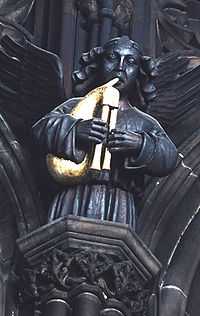English bagpipes

The English bagpipes are bagpipes played in England. Of these, the only continuous tradition is that of the Northumbrian smallpipes, which are used in the northeastern county of Northumberland.
Although bagpipes had formerly been used in other parts of England dating back at least to the Middle Ages, all but the Northumbrian smallpipes died out. Their reconstruction is a contested issue, as several distinct types of "extinct" bagpipes have been claimed and "reconstructed" based upon iconography or textual clues from English historical sources, though in all cases no undisputed physical examples remain.
Bagpipes are mentioned in English literature as early as The Canterbury Tales by Geoffrey Chaucer, written between the 1380s and 1390s. Writing in the Prologue about the Miller, the lines read:
| “ | A baggepype wel coude he blowe and sowne, And ther-with-al he broghte us out of towne. |
” |
Stone and wood carvings of bagpipes of many different types began to appear in English cathedrals and churches beginning in the 14th century; examples of such carvings may be found in Cornwall, Dorset, Devon, Herefordshire, Yorkshire, Cambridgeshire, Manchester, Norfolk, and Shropshire.[1][2][3]
Regional pipes
- Lancashire: The Lancashire bagpipe or Lancashire greatpipe has been attested in literature, and commentators have noticed that the Lancashire bagpipe was also believed proof against witchcraft.[4]
- Leicestershire: Numerous reproductions of the Leicestershire smallpipes have been made by pipemaker Julian Goodacre since the late 20th century.
- Lincolnshire: The Lincolnshire bagpipes were mentioned in literature since the time of Shakespeare, and in 2010 sets were re-created based on artistic depictions found in Lincolnshire churches.
- Yorkshire: The Yorkshire bagpipes are attested in literature, but are currently extinct.
- Worcestershire: The Worcestershire bagpipe has likewise been attested in literature, with the men of that county noted as famed for their love of piping. The instrument is currently extinct.
Controversy over the validity of "reconstruction"
This process of reconstruction is controversial. Some British pipers and pipemakers, such as Julian Goodacre, have "reconstructed" several types of claimed extinct bagpipes, based on iconography and inconclusive textual clues. Other enthusiasts dispute these findings, as detailed in James Merryweather's article Regional Bagipes: History or Bunk?[5]
While dismissing much research as optimistic interpretations of the source materials, Merryweather claimed to have found indisputable evidence of a bagpiper in Liverpool in 1571. Per Merryweather, the records of the Liverpool Wait makes a single mention of one "henrie halewod bagpiper".[6]
Other bagpipes of the British Isles undergoing reconstruction
- Cornish bagpipes
- Welsh pipes (claimed physical examples survive from the 17th and 18th centuries)
- Zetland pipes
Sources
- Stewart, Pete (2001). Robin With the Bagpipe: The English Bagpipe and Its Music. Ashby Parva: White House Tune Books. ISBN 0-907772-52-8.
- English Manuscript Studies, 1100-1700 - Google Books Result
- JSTOR: Pipers' Pabulum
- JSTOR: Music in the World's Proverbs
- JSTOR: Two-Chanter Bagpipes in England
- JSTOR: Chaucer's Millers and Their Bagpipes
- The Witches of Lancashire - Google Books Result
- Lancashire - Records of Early English Drama
- Notes on Lancashire parish Registers
- The Fiddler’s Companion, Andrew Kuntz
- R D Cannon, The Bagpipe in Northern England, Folk Musical Journal Number 2 (1971)
- Alfred Welby The Lincolnshire Bagpipe Oxford University Press, 1930.
- M.H. Dobbs The Lincolnshire Bagpipe Oxford University Press, 1930.
- Stephen Taggart The Lincolnshire Bagpipes Early Music, Vol. 4, No. 3 (Jul., 1976), pp. 363-365.
- Franz Montgomery The Musical Instruments in "The Canterbury Tales". The Musical Quarterly 1931 XVII(4):439-448; doi:10.1093/mq/XVII.4.439
Historical images
- http://www.prydein.com/pipes/2chanter/index.html
- http://www.prydein.com/pipes/2chanter/pagetwo/index.html
- http://www.prydein.com/pipes/exeter/index.html
- http://www.prydein.com/pipes/tapestry/index.html
References
- ↑ Bagpipe Carvings
- ↑ Bagpipe Carvings
- ↑ Bagpipe Paintings: The Bagpiper of Exeter
- ↑ Transactions, Volume 56North of England Institute of Mining and Mechanical Engineers, 1908. Pg cviii
- ↑ James Merryweather Regional Bagipes: History or Bunk?
- ↑ James Merryweather Henry Halewood: Bagpipe and Liverpool Town Wait 1571-1589